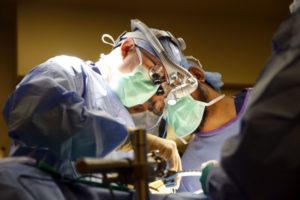Pain Increases After Knee Replacement Surgery

Dr. Tollestrup working on a previous knee replacement surgery.
Wanda had a left total knee replacement done by her orthopedic surgeon.
Unfortunately, after surgery, she still suffered from terrible pain. In fact, physical therapy made her pain worse. During physical therapy, she was using a Continuous Passive Motion machine. The more Wanda used the CPM machine, the more she started experiencing numbness and tingling involving the skin over the inside of her lower leg and pain on the inside of her ankle.
In addition, she started having severe, radiating pain starting near the inside of her knee and traveling up her inner thigh into the groin area.
Orthopedic Surgeon Denies Pain
Baffled by the cause of her persistent knee pain, Wanda’s orthopedic doctor just continued to send her to physical therapy. In total, Wanda participated in three rounds of physical therapy. Despite extensive therapy, Wanda’s symptoms never improved.
Wanda’s orthopedic surgeon told her many times that he didn’t understand how she could still be having pain and that everything was perfect with her knee replacement. Eventually, her surgeon started to intimate that the problem was all in Wanda’s head. Unfortunately for patients suffering from peripheral nerve damage, this is not an uncommon experience.
Finding Relief
Luckily for Wanda, her husband researched constantly on the internet and found Dr. Tollestrup. Wanda then came to see Dr. Tollestrup for an evaluation.
After learning about her arthroplasty, Dr. Tollestrup knew that Wanda had most likely undergone an unnecessary surgery because her knee pain before surgery was exactly the same as after the knee replacement. He also suspected that the source of her ongoing pain stems from the small sensory nerves that give sensation to the soft tissue around the knee joint itself.
Based on the description of the location of the new pain and numbness from the groin down to the inside of the ankle that Wanda started to experience after the knee surgery, Dr. Tollestrup also knew that there was a problem with Wanda’s saphenous nerve. A brief physical exam confirmed that the saphenous nerve was being compressed or pinched deep in the inner thigh in a tight space called the adductor canal. Using local anesthetic, Dr. Tollestrup put to sleep the small sensory nerves causing the pain in the area of the left knee. This gave Wanda immediate, temporary relief from her left knee pain, thus confirming Dr. Tollestrup’s diagnosis.
Disconnecting Damaged Nerves
With the accurate diagnosis made, Dr. Tollestrup took Wanda to the operating room.
Through a single incision just above the knee on the inside of the thigh, he was able to find and disconnect all of the damaged nerves to the knee. He also relieved the pressure on the main saphenous nerve in the adductor canal.
Click here to watch this video from the operating room showing exactly what Dr. Tollestrup did in surgery.
By the time Wanda came back to see Dr. Tollestrup for her one-week post-op visit, all of the original pain in the left knee was gone. The sensation on the inside part of the lower leg had returned to normal. She was no longer experiencing the shooting pain up the inside of her left thigh into the groin or the pain on the inside of her ankle.
“I don’t have any pain at all,” Wanda said. “I am so happy I found Dr. Tollestrup.”
If you or someone you know has persistent knee pain before or after a knee arthroplasty, Dr. Tollestrup may be able to help. Please fill out the form on the right or call the office at 702.666.0463.
